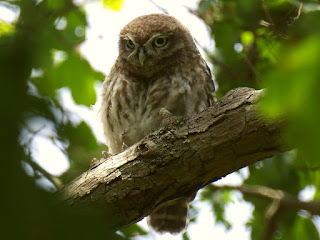The young Reed Warblers beside the bridge are now feeding themselves, though still occasionally begging when their parents are in sight. They were perching on the low netting in front of the reed bed and leaping into the grass whenever they saw an insect. They were not in the least disturbed by several people watching and photographing them.
The adults were catching damselflies, of which there were four kinds: Common Blue, Blue-Tailed, Azure and Small Red-Eyed. Fortunately this lovely Banded Demoiselle escaped their notice.
And the birds gave a wide berth to this creature, a Banded Hoverfly (Volucella zonaria). Although harmless and edible, it has a colour scheme that mimics that of a hornet, a most effective form of defence.
In the same patch of grass, a young Wren was sunbathing.
Beside the reed bed, some Moorhens had brought out their four very young chicks. They must have been nesting in the disused drain here, the second brood of the year in this place. A Coot came too near and one of the Moorhens went for it and drive it off, the fury of defending the family fiving it the advantage over the larger bird.
The two Little owlets were bouncing around in their tree.
I have a confession about this tree. I had described it as an oak, because it is next to two oak trees farther up the hill, and I had been so busy photographing the owls that I hadn't looked at the leaves. It is in fact a Large Field Maple. Many apologies to anyone I have misled.
Both the adult Little Owls had tired of the antics of their young and retreated to the nest tree and the chestnut just down the hill where they nested last year. Here is the male looking out of the nest tree.
The Great Crested Grebe family were again invisible behind the baskets of plants surrounding the island. This is a different grebe, a male to judge by his wide crest, preening himself elegantly on the other side of the lake.
The Mallard on the Round Pond still has four ducklings. They were nonchalantly swimming around only feet from a couple of bull terriers that their idiotic owners were encouraging to swim in the pond, and which kept swimming towards them. I'm reminded of the story that Dr Johnson told to Boswell about his time at university. He failed to visit his tutor for four days running, then turned up and casually told the man that he had not come because he had been sliding on the ice in Christ Church Meadow. BOSWELL. "That, Sir, was great fortitude of mind." JOHNSON. "No, Sir, stark insensibility."
The sunny day had encouraged a Song Thrush to sing, very late in the season, from the top of a weeping beech in the flower walk.









I watched a Grebe having a beak-to-tail wash at Sonning yesterday. I have never seen such thorough ablutions! Until they stand up in the water and flap about, you don't appreciate how much of them is actually blazing white!
ReplyDeleteThe brilliant while underneath makes them as invisible from below as possible, which helps to avoid frightening fish away.
DeleteOh that is so interesting. I thought it was just an elegant get up!
DeleteSorry, Ralph, it is not a Norway maple, but a large field maple (Acer campestre)!
ReplyDeleteMario
Thanks again. Changed.
Delete